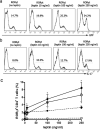Cutting edge: Leptin-induced RORγt expression in CD4+ T cells promotes Th17 responses in systemic lupus erythematosus
- PMID: 23447682
- PMCID: PMC3608794
- DOI: 10.4049/jimmunol.1203275
Cutting edge: Leptin-induced RORγt expression in CD4+ T cells promotes Th17 responses in systemic lupus erythematosus
Abstract
Th17 CD4(+) cells promote inflammation and autoimmunity. In this study, we report that Th17 cell frequency is reduced in ob/ob mice (that are genetically deficient in the adipokine leptin) and that the administration of leptin to ob/ob mice restored Th17 cell numbers to values comparable to those found in wild-type animals. Leptin promoted Th17 responses in normal human CD4(+) T cells and in mice, both in vitro and in vivo, by inducing RORγt transcription. Leptin also increased Th17 responses in (NZB × NZW)F1 lupus-prone mice, whereas its neutralization in those autoimmune-prone mice inhibited Th17 responses. Because Th17 cells play an important role in the development and maintenance of inflammation and autoimmunity, these findings envision the possibility to modulate abnormal Th17 responses via leptin manipulation, and they reiterate the link between metabolism/nutrition and susceptibility to autoimmunity.
Figures



Similar articles
-
Leptin promotes systemic lupus erythematosus by increasing autoantibody production and inhibiting immune regulation.Proc Natl Acad Sci U S A. 2016 Sep 20;113(38):10637-42. doi: 10.1073/pnas.1607101113. Epub 2016 Sep 1. Proc Natl Acad Sci U S A. 2016. PMID: 27588900 Free PMC article.
-
The E3 deubiquitinase USP17 is a positive regulator of retinoic acid-related orphan nuclear receptor γt (RORγt) in Th17 cells.J Biol Chem. 2014 Sep 12;289(37):25546-55. doi: 10.1074/jbc.M114.565291. Epub 2014 Jul 28. J Biol Chem. 2014. PMID: 25070893 Free PMC article.
-
RORγt expression in Tregs promotes systemic lupus erythematosus via IL-17 secretion, alteration of Treg phenotype and suppression of Th2 responses.Clin Exp Immunol. 2017 Apr;188(1):63-78. doi: 10.1111/cei.12905. Epub 2017 Jan 5. Clin Exp Immunol. 2017. PMID: 27880975 Free PMC article.
-
PPARα suppresses Th17 cell differentiation through IL-6/STAT3/RORγt pathway in experimental autoimmune myocarditis.Exp Cell Res. 2019 Feb 1;375(1):22-30. doi: 10.1016/j.yexcr.2018.12.005. Epub 2018 Dec 14. Exp Cell Res. 2019. PMID: 30557558
-
HIF-1α and miR-210 differential and lineage-specific expression in systemic lupus erythematosus.Mol Immunol. 2021 May;133:128-134. doi: 10.1016/j.molimm.2021.02.019. Epub 2021 Feb 28. Mol Immunol. 2021. PMID: 33657462 Free PMC article.
Cited by
-
Leptin Downregulates Angulin-1 in Active Crohn's Disease via STAT3.Int J Mol Sci. 2020 Oct 22;21(21):7824. doi: 10.3390/ijms21217824. Int J Mol Sci. 2020. PMID: 33105684 Free PMC article.
-
Leptin and Asthma: What Are the Interactive Correlations?Biomolecules. 2022 Nov 29;12(12):1780. doi: 10.3390/biom12121780. Biomolecules. 2022. PMID: 36551211 Free PMC article. Review.
-
Serum inflammatory factors, vitamin D levels, and asthma severity in children with comorbid asthma and obesity/overweight: a comparative study.Front Pediatr. 2025 Feb 27;13:1439841. doi: 10.3389/fped.2025.1439841. eCollection 2025. Front Pediatr. 2025. PMID: 40083433 Free PMC article.
-
Neuro-endocrine networks controlling immune system in health and disease.Front Immunol. 2014 Apr 7;5:143. doi: 10.3389/fimmu.2014.00143. eCollection 2014. Front Immunol. 2014. PMID: 24778633 Free PMC article. Review.
-
Association between leptin and systemic lupus erythematosus.Rheumatol Int. 2014 Apr;34(4):559-63. doi: 10.1007/s00296-013-2774-4. Epub 2013 May 11. Rheumatol Int. 2014. PMID: 23666119 Review.
References
-
- Zhang F, Basinski MB, Beals JM, Briggs SL, Churgay LM, Clawson DK, DiMarchi RD, Furman TC, Hale JE, Hsiung HM, Schoner BE, Smith DP, Zhang XY, Wery JP, Schevitz RW. Crystal structure of the obese protein leptin-E100. Nature. 1997;387:206–209. - PubMed
-
- Zhang Y, Proenca R, Maffei M, Barone M, Leopold L, Friedman JM. Positional cloning of the mouse obese gene and its human homologue. Nature. 1994;372:425–432. - PubMed
-
- Lord GM, Matarese G, Howard JK, Baker RJ, Bloom SR, Lechler RI. Leptin modulates the T-cell immune response and reverses starvation-induced immunosuppression. Nature. 1998;394:897–901. - PubMed
-
- La Cava A, Matarese G. The weight of leptin in immunity. Nat. Rev. Immunol. 2004;4:371–379. - PubMed
-
- De Rosa V, Procaccini C, Calì G, Pirozzi G, Fontana S, Zappacosta S, La Cava A, Matarese G. A key role of leptin in the control of regulatory T cell proliferation. Immunity. 2007;26:241–255. - PubMed
Publication types
MeSH terms
Substances
Grants and funding
LinkOut - more resources
Full Text Sources
Other Literature Sources
Medical
Molecular Biology Databases
Research Materials
Miscellaneous

